Hello. I am Christopher Wilson
User Experience Engineer
Design Researcher
Car Enthusiast
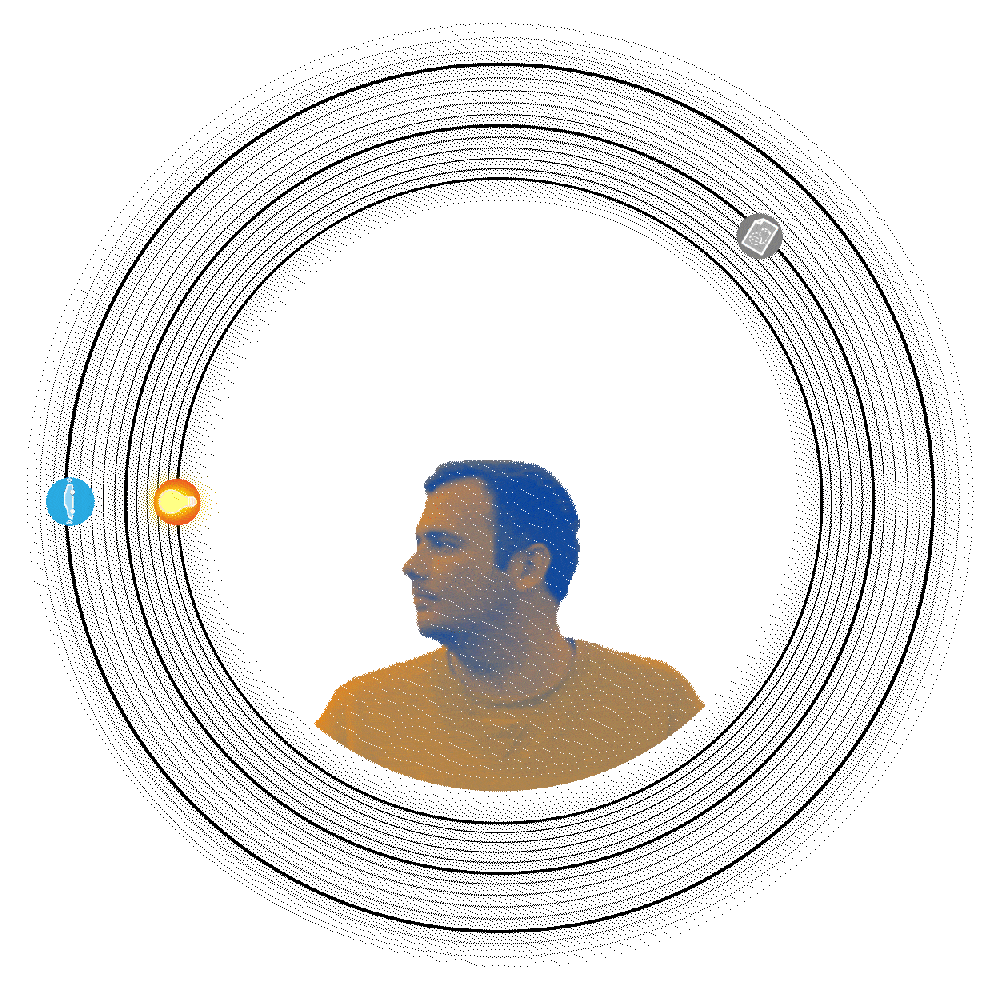
Hello. I am Christopher Wilson
A UX and Human Factors specialist with a background that bridges digital design, service design, physical product development, and engineering. I currently lead a UX Research team working on automated driving systems: bringing together strategy, research, and design to create intuitive, user-centred solutions in a complex environment.
Re-inventing the Journey Experience:
A Service Design Approach to the Autonomous Vehicle Experience
My Role:
Lead Researcher & Experience Designer.
Team & Collaboration:
PhD research conducted at Loughborough University in collaboration with Nissan Motor Co. Ltd.
Timeline:
2019-2022
The Challenge:
The automotive industry is undergoing a paradigm shift (ACES: Autonomous, Connected, Electrified, Shared). With fully autonomous vehicles (SAE Level 4), the “driver” becomes a “passenger,” freeing up significant time. However, vehicles are not currently designed to support this new reality.
The Goal:
To move beyond technical feasibility and define the human-centered, ergonomic design requirements for a positive and productive journey experience in a future autonomous vehicle.
What do people want and need to do in an autonomous car, and how must the vehicle’s interior service that experience?
DISCOVER: Understanding the User & the Ecosystem
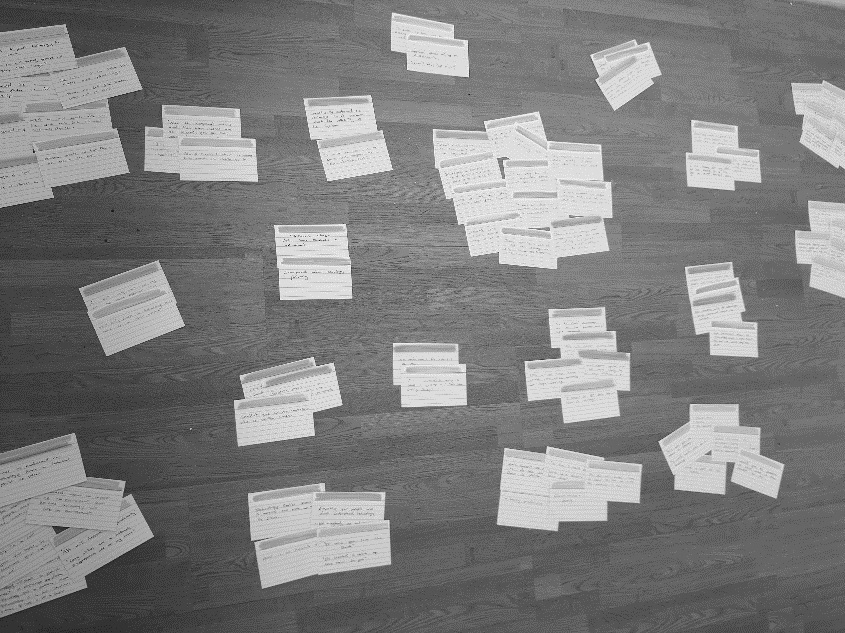
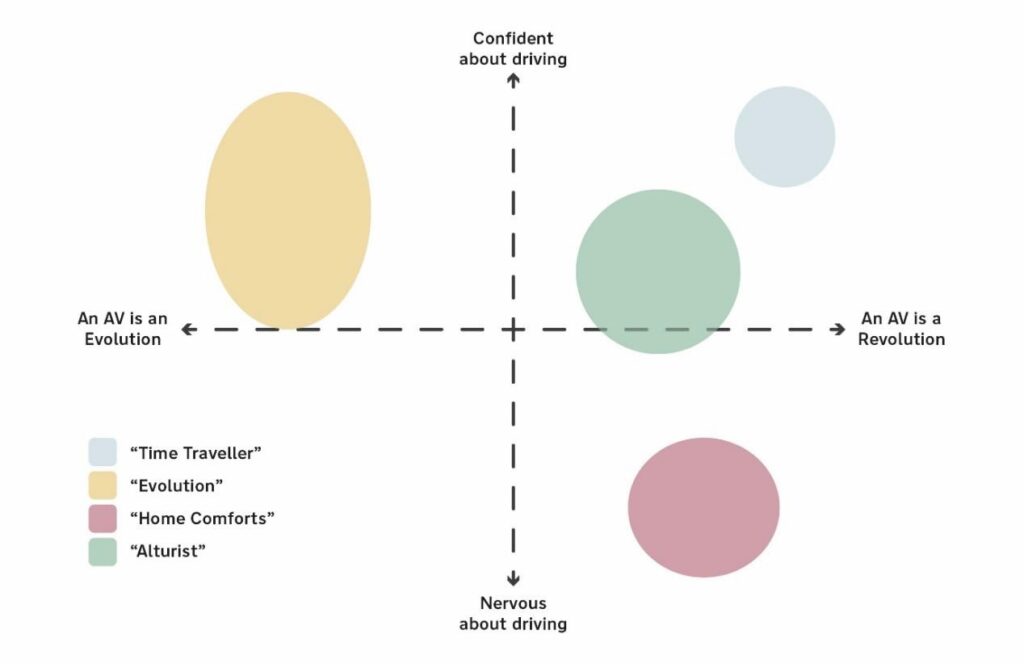
Aim:
To identify the needs, goals, and primary journey of likely future autonomous vehicle (AV) owners.
Skills and Tools:
- Literature Review
- Surveying
- Interviews
- Thematic Analysis
- SPSS
Outcome:
A rich dataset from a 1378-participant global survey and 18 in-depth interviews, revealing key user segments and their primary goals for using an autonomous vehicle.
Key Findings:
- A significant segment of the market (42% of drivers) are likely to adopt AVs.
- This “likely adopter” group is motivated by perceived benefits in safety and efficiency and sees their current commute as “wasted time”.
- The top desired activities are Leisure (88%), Rest (75%), and Productivity (55%).
- The daily commute is the most critical user journey to redesign, selected by 50% of interviewees as their most likely autonomous trip.
Following the literature review, the first empirical phase of research aimed to gather primary data to address the identified knowledge gaps. The goal was to build a deep understanding of likely AV adopters through a mixed-methods approach.
Methodology 1: Global Survey
A 42-question online survey was developed and distributed globally to a broad, English-speaking audience, resulting in 1,378 valid responses. The survey was approved by the Loughborough University Ethics Committee and conformed to GDPR. To ensure all participants had a shared understanding of the technology, the survey included a sensitisation page that described an SAE Level 4 vehicle as one that can “drive itself on motorways, A roads, city centres and parking lots,” freeing the occupant to “discard the steering wheel and pedals and be free to do other activities”. The questionnaire adapted questions from existing literature, including the Car Technology Acceptance Model (CTAM), to gauge attitudes towards technology and vehicle autonomy. The data was analysed using IBM SPSS, employing Mann-Whitney-U tests to identify significant differences between population groups.
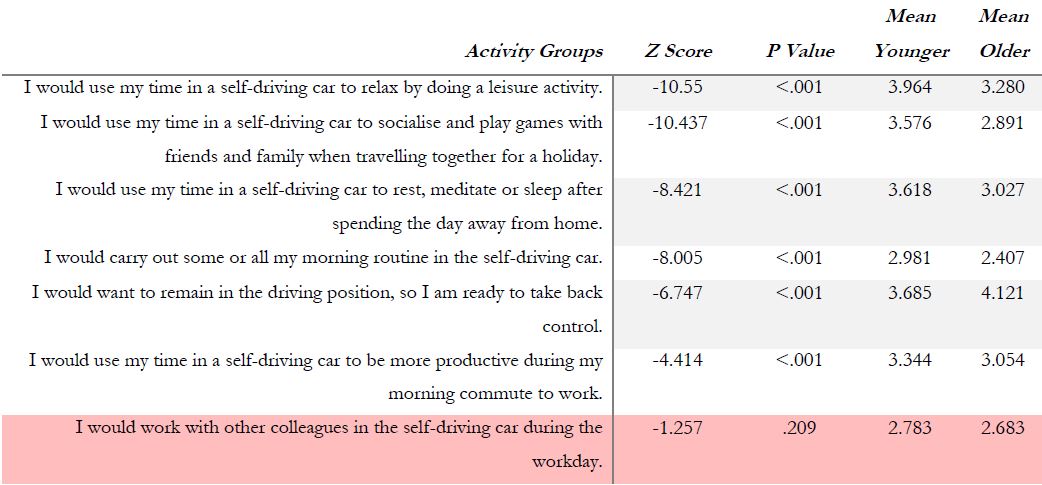
Table showing activity goal preference differences between older and younger participants.
Methodology 2: In-depth Interviews
To add qualitative depth to the survey findings, 18 semi-structured, in-depth interviews were conducted with participants identified by the survey as being most likely to own an autonomous vehicle. The interviews, which averaged 40 minutes in length, were conducted remotely and aimed to explore the motivations, activities, and concerns of these early adopters in more detail. A semi-structured format was used, guided by a prompt sheet, to allow for both consistency and the flexibility to explore emergent themes. Analysis was conducted thematically using flashcards to code the transcripts, which allowed for the identification of key patterns and user attitudes toward the future journey experience.
- The research successfully engaged a large, diverse sample through a global survey (n=1378) and obtained deep qualitative insights through targeted interviews (n=18).
- A key methodological step was the use of a sensitisation page to ensure participants had a common and accurate understanding of SAE Level 4 capabilities before answering questions about autonomy.
- The sequential mixed-methods approach was effective: the quantitative survey identified the “likely adopter” segment, which then allowed for highly targeted qualitative interviews to explore their specific needs.
DEFINE: Synthesizing Needs & Framing the Opportunity
Aim:
To synthesize the research data into actionable insights, define the core user, and frame the primary design problem to be solved.
Skills and Tools:
- Persona building
- Stakeholder management
- Data synthesis
Outcome:
The creation of the lead persona, “Sonia,” and the strategic decision to focus the design effort on transforming the daily commute.
Part A: User Personas
From the rich survey and interview data, I developed four distinct personas to represent the attitudes of likely future AV owners. This helped to focus the design process on specific user needs and goals. Our lead persona became ‘Sonia Burgess,’ a 30-year-old lawyer who sees commuting as an ‘inappropriate use of my time’ and wants to reclaim it for productivity.
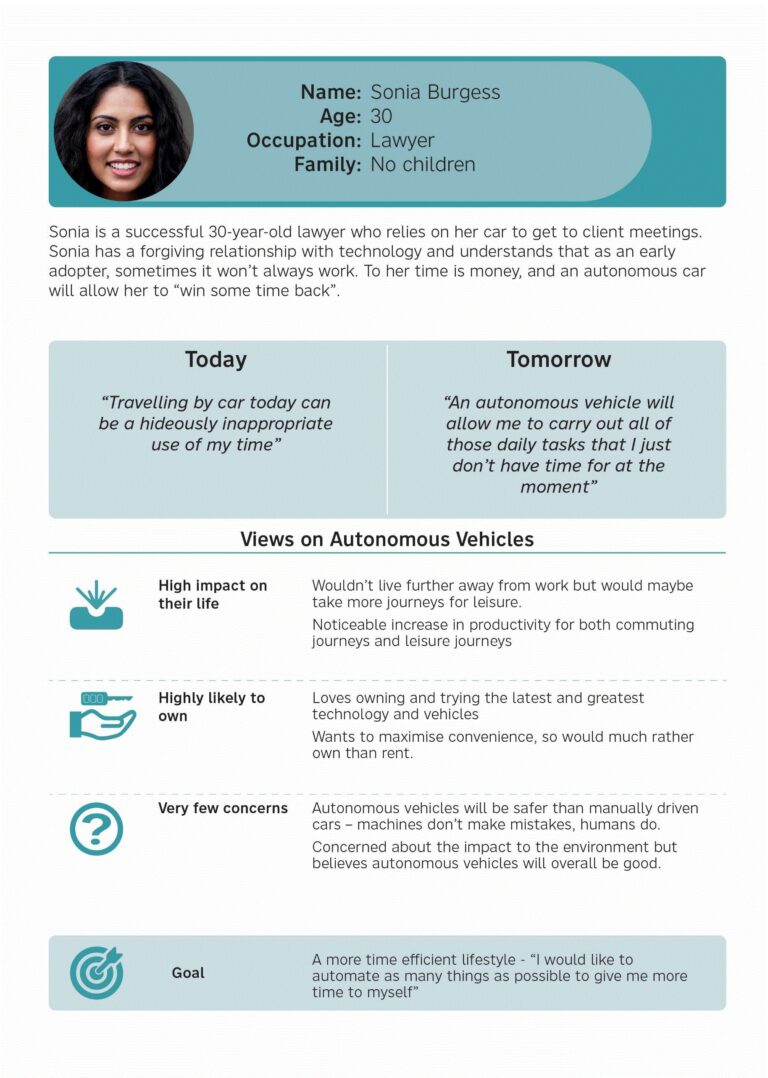
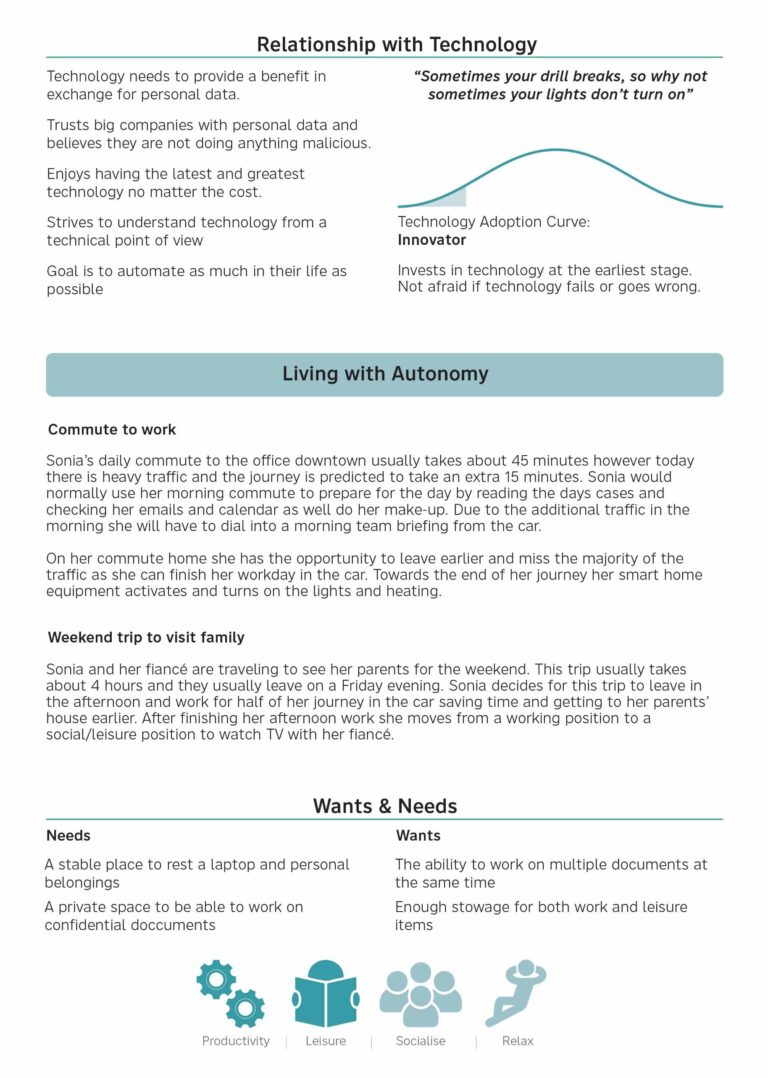
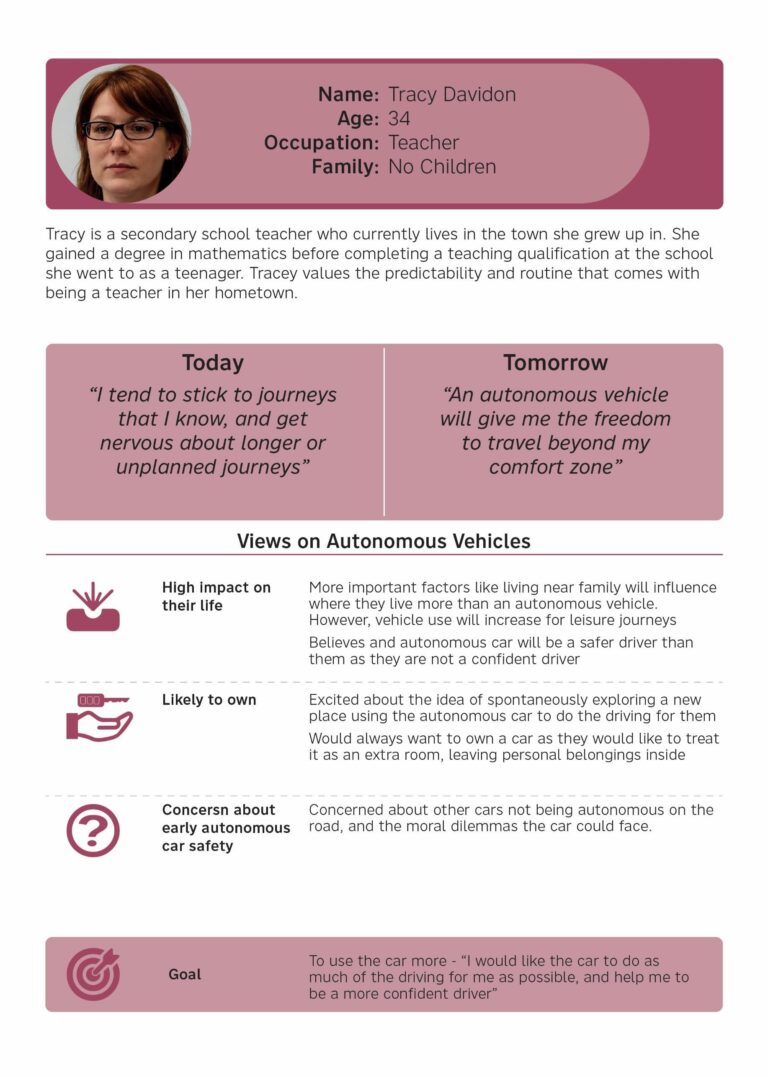
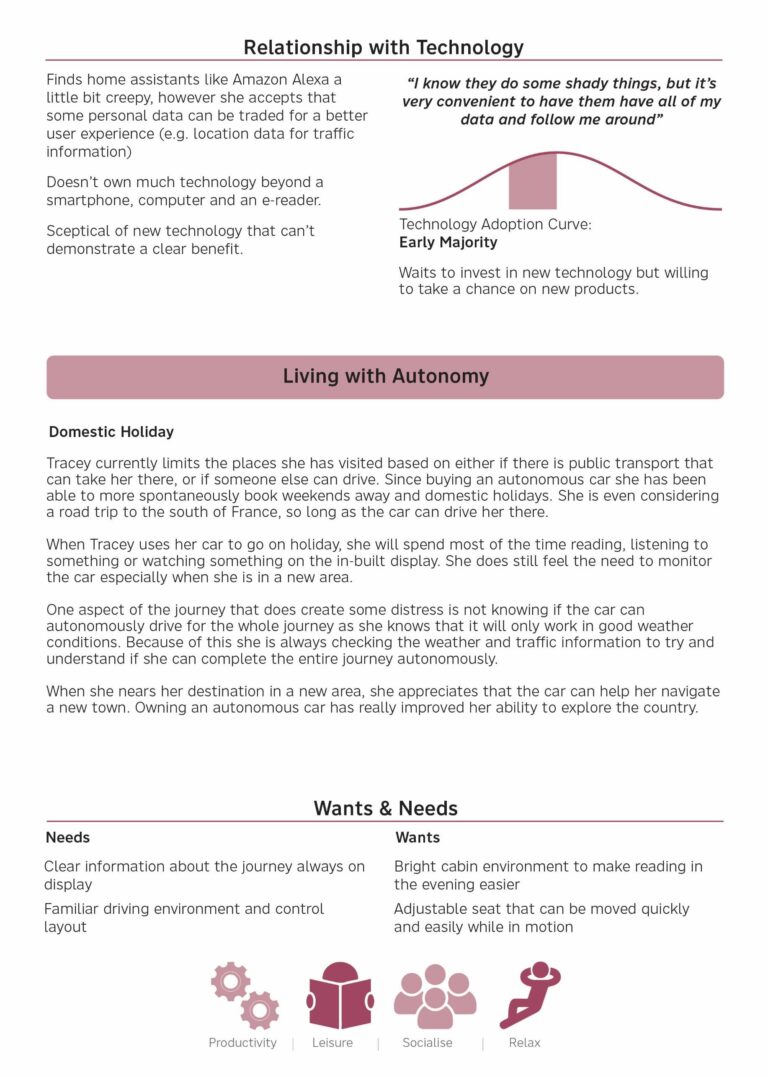
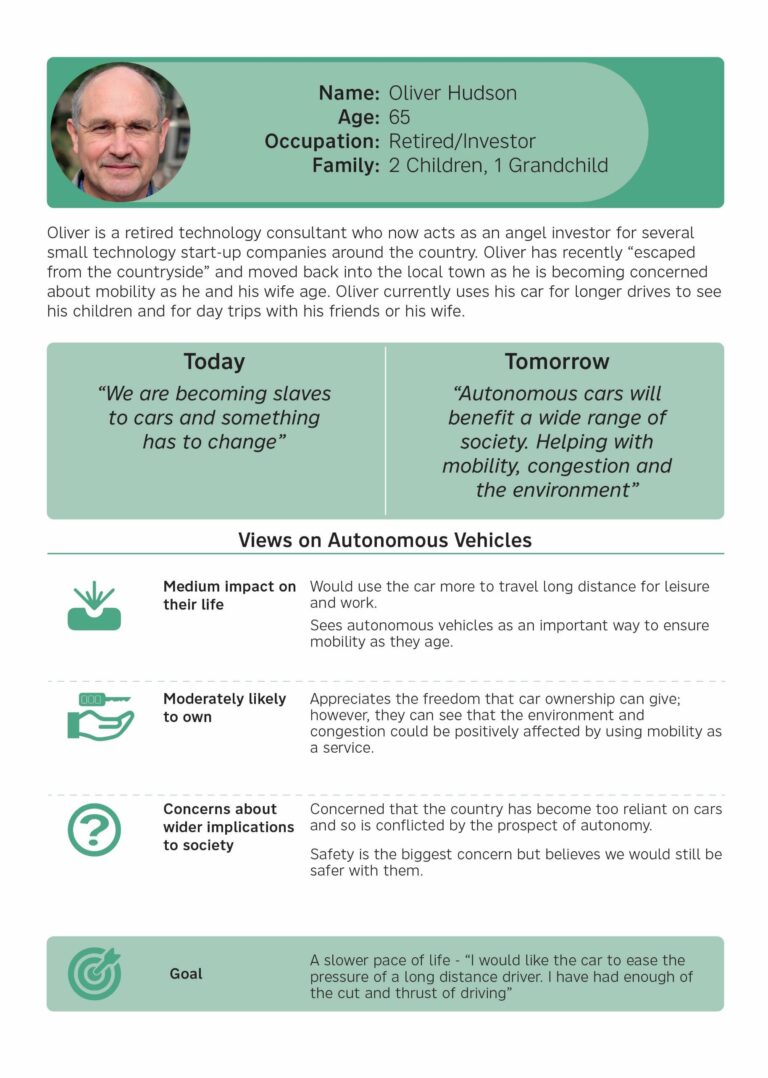
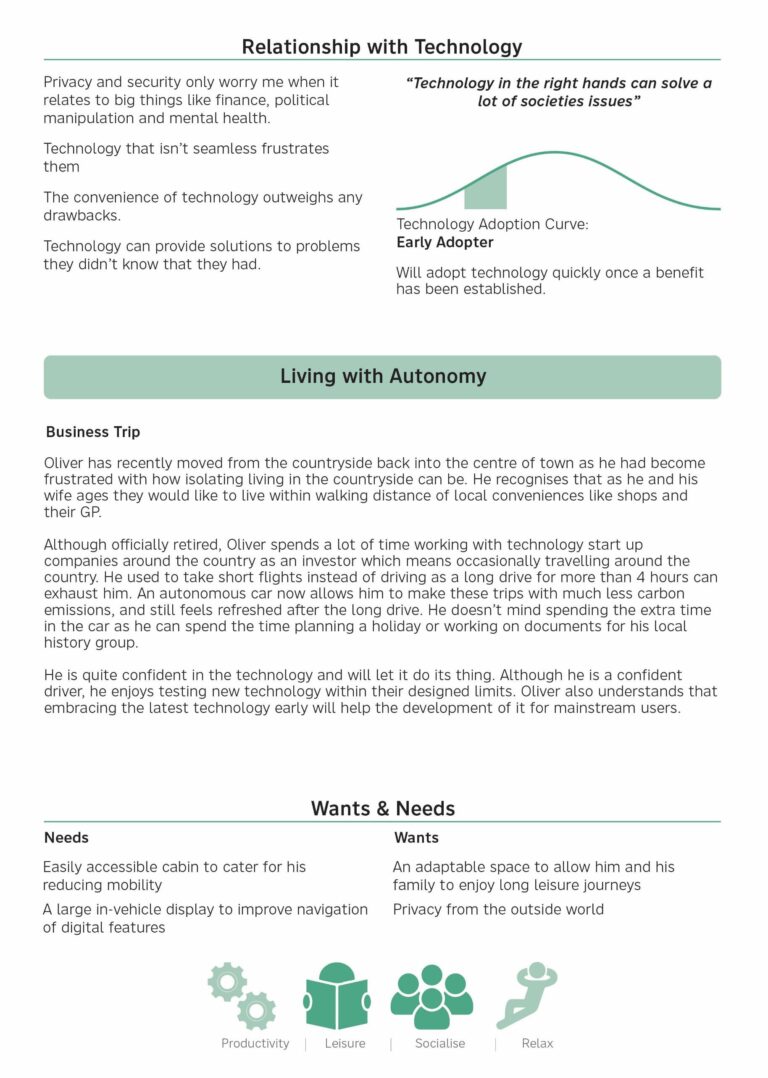
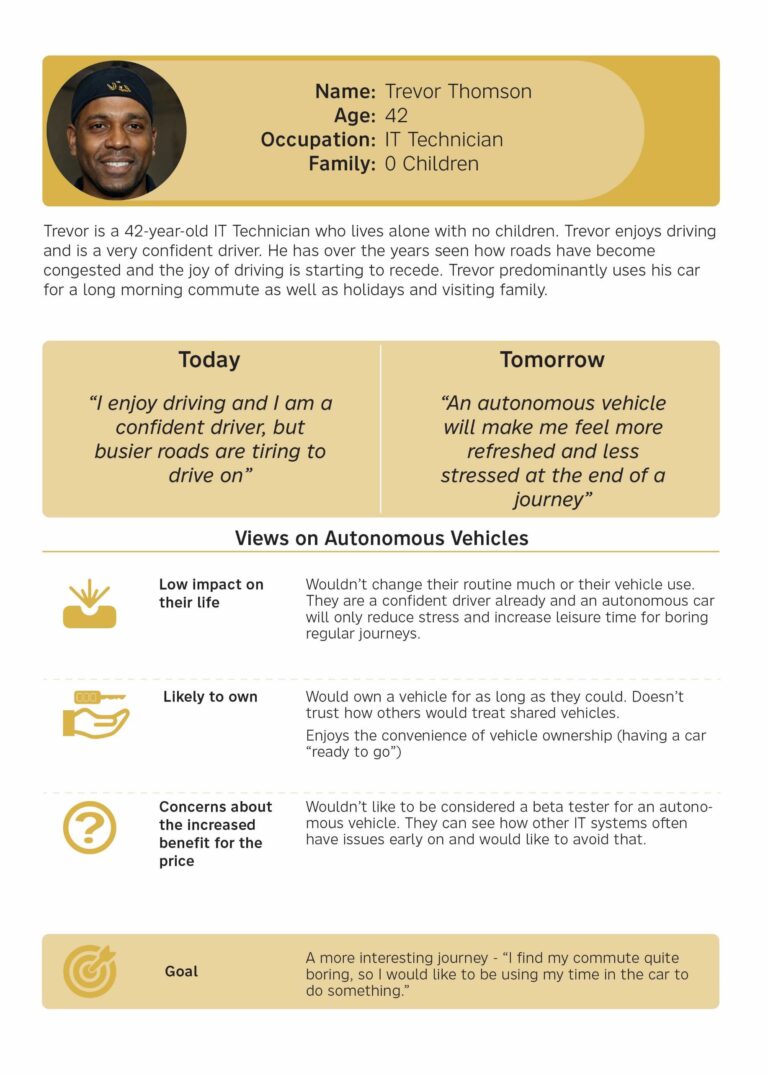
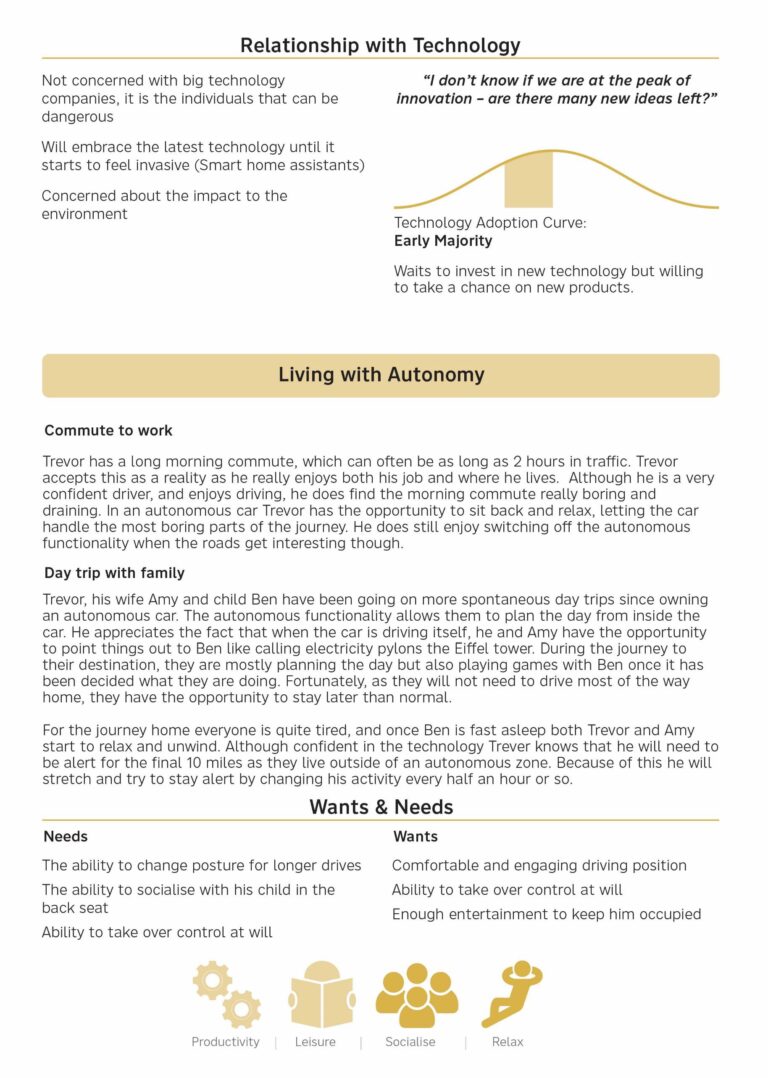
Part B: Defining the Core Service & Journey
The research clearly pointed to the daily commute as the primary journey to reimagine. This journey presented the most diverse range of user needs and the biggest opportunity for improving the user’s quality of life. Based on Sonia’s needs, we framed the core design challenge.
Part C: “How Might We” Statements
- How Might We transform the commute from a “waste of time” into a valuable, productive third space for professionals like Sonia?
- How Might We design an interior that seamlessly supports a transition between tasks like working on a laptop, taking a video call, and relaxing?
- How Might We ensure physical comfort and well-being during a 45-minute journey where the occupant is engaged in non-driving tasks?
The Define phase focused on synthesizing the rich data from the Discover phase into actionable insights. The goal was to identify the primary user, their most critical journey, and their core needs, which would frame the subsequent design and prototyping work.
Defining the “Likely Adopter” Profile
The survey analysis revealed a distinct user segment of “likely adopters,” which constituted 42% of all respondents. This group held significantly more positive views on autonomy compared to the general population. For example, 86% believed autonomous vehicles will reduce the risk of accidents, and 76% believed they would reduce traffic congestion. This group was also significantly more likely to find current motorway journeys a “waste of time,” highlighting a clear pain point to be addressed.
Defining User Goals and the Critical Journey
The desire to repurpose travel time was paramount. The survey data showed that the top desired activity categories for likely adopters were Leisure (88% agreed they would partake), Resting/Sleeping (75%), Socialising (70%), and being Productive (55%). The in-depth interviews provided crucial context for where these activities would take place. When asked to identify their most important future journey, 50% of interview participants chose the daily commute , as it offered the greatest potential for time-saving and encompassed the most diverse range of desired NDRTs (24 unique activities mentioned in interviews, including working, eating, and personal grooming).
Persona Development
To translate these findings into a relatable design tool, four data-driven personas were created. The lead persona, “Sonia,” a 30-year-old lawyer, was selected in consultation with the industry sponsor as she represented the most complex design challenge. Her motivation is captured by her statement that her current commute is a “hideously inappropriate use of my time” and her goal is to use an AV to “win some time back”.
DEVELOP: Prototyping & Testing the Experience
Aim:
To prototype and test various interior concepts to define the specific spatial and ergonomic requirements needed to support in-car productivity and comfort.
Skills and Tools:
- Co-Design
- Ergonomics
- Simulator design
- Catia V5
- R Studio
- Statistics
Outcome:
The definition of a new “Productivity Posture” and the key finding that users require over 255mm of rearward seat travel to work comfortably and safely.
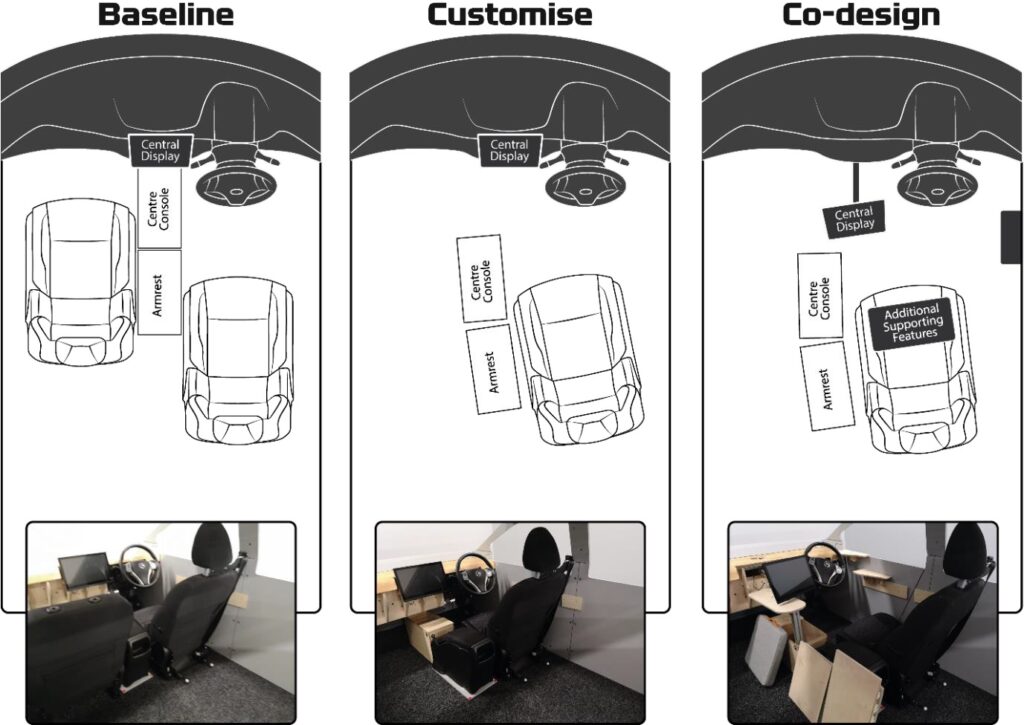
Key Findings:
- Laptop work grew from 20% to 46% of journey time as the interior became more supportive.
- Providing support features led to a significant decrease in discomfort and 28% less sustained neck flexion.
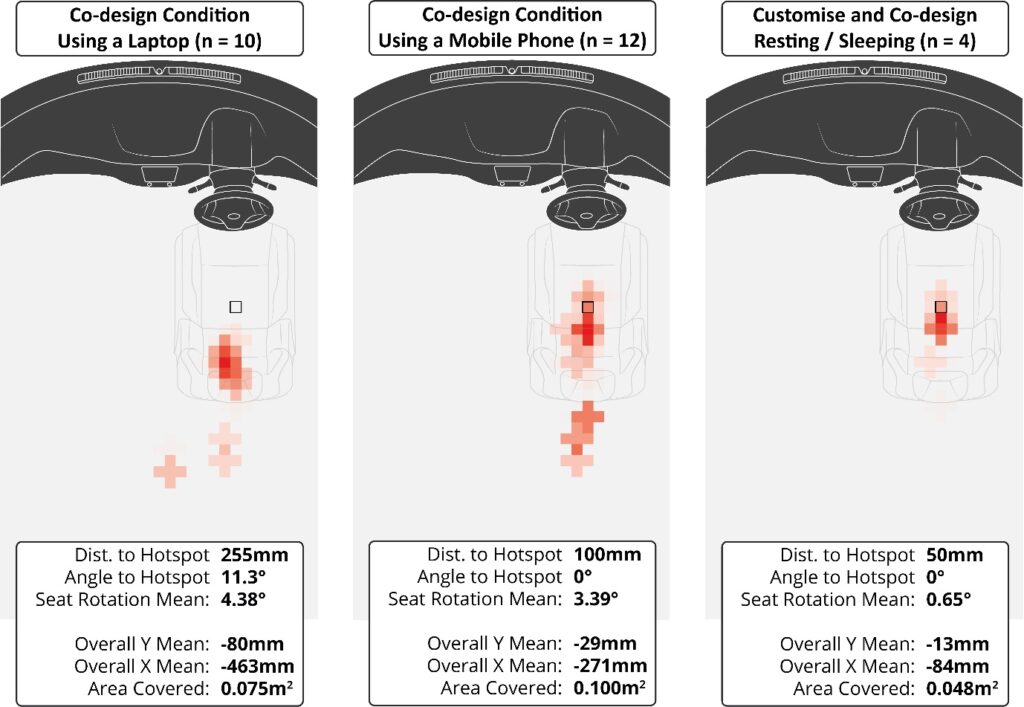
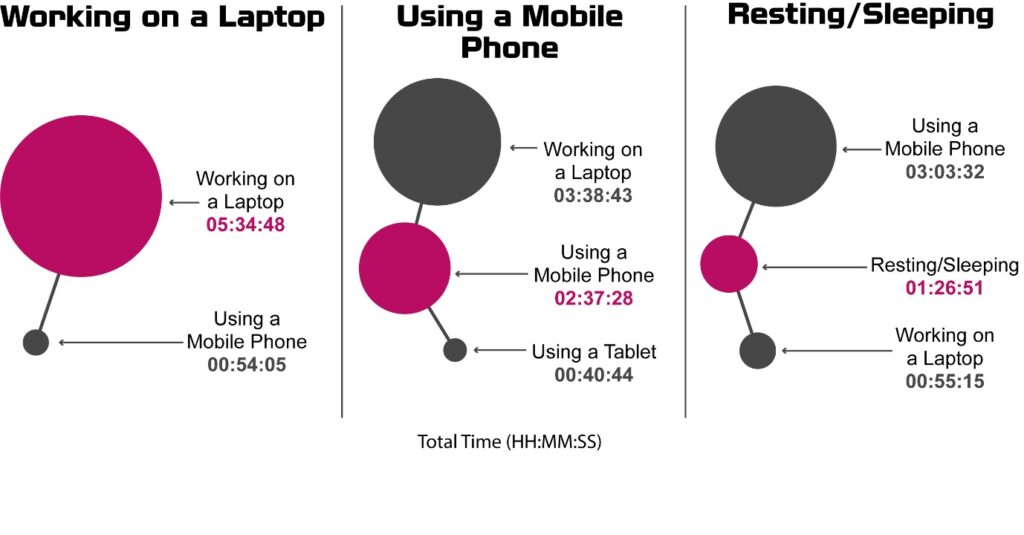
This phase aimed to physically explore and validate design requirements through two prototyping studies: a “macro” study of the entire interior space and a “micro” study focused on the critical seat and workstation components.
“Macro” Prototyping: The Simulator Study
Methodology:
A driving simulator study was conducted with 16 participants to investigate space utilisation, comfort, and NDRTs during a 45-minute simulated commute. A vehicle ‘buck’ was constructed with interior dimensions based on a production vehicle (2017 Nissan Qashqai) to ensure realism. The driver’s seat was mounted on a bespoke frame with ball transfer units, allowing it to move and rotate freely. A novel method using a GoPro camera and Kinovea software was developed to track the seat’s X, Y, and rotational position. Participants experienced three iterative conditions: ‘Baseline’ (fixed interior), ‘Customise’ (open space), and ‘Co-design’ (with added supporting features like lap tables). Comfort was assessed using the Body Part Discomfort Scale at two points during each session.
Findings:
Laptop use grew from 20% of the journey time in the baseline condition to 46% in the co-design condition, while mobile phone use decreased from 34% to 22%. To work on a laptop, users moved the seat to an average position 255mm rearward of the driving position. This added space and the co-designed features resulted in a significant decrease in discomfort (p<0.05) for the backrest and headrest and reduced the frequency of sustained neck flexion (for postures held over 10 minutes) by 28% between the first and third conditions.
“Micro” Prototyping: The Ergonomic Fitting Trial
Methodology:
The simulator study highlighted that a conventional seat is not designed for a working posture. Therefore, a static fitting trial was conducted with 22 participants to define the optimal seat and workstation parameters for a “low H-point” working environment. A bespoke, highly adjustable seat rig was constructed, with foam hardness and material designed to closely match a production automotive seat (Density: ~67.8kg/m³ for cushion, ~57.6kg/m³ for backrest) to ensure realism. Participants adjusted 16 degrees of freedom on the seat and an adjustable work surface until they found their optimal comfort for working on a laptop.
Findings:
The trial identified a new “Productivity Posture.” Compared to a traditional driving posture found in previous literature, this posture showed a significant difference in trunk angle, indicating a more reclined backrest (M=21.4° for males, M=17.4° for females) and a steeper cushion angle. The research also found a very strong positive correlation between surface height and armrest height, while no significant correlation was found between armrest height and user anthropometry.
Key Findings
- User behavior evolves with better tools; laptop use grew from 20% to 46% of journey time as the interior became more supportive.
- To work comfortably on a laptop, users require significant additional space, moving an average of 255mm rearward from the standard driving position.
- Providing adaptable features like lap tables can significantly improve comfort (significantly for backrest and headrest) and posture (28% reduction in sustained neck flexion).
- A new, comfortable “Productivity Posture” was identified, which features a more reclined backrest and steeper cushion angle than a traditional driving posture (significant difference in trunk angle).
- Seat design for AVs should incorporate additional articulation of approximately +/- 5° in the upper backrest and front cushion areas to achieve optimal comfort.
- The workstation and armrests should be designed as an integrated system, as their heights are strongly correlated, and independent of the user’s seat.
Outcome & Industry Recommendations
Part A: Key Design Principles for the Autonomous Commute Service
- Principle 1: Design for a ‘Productivity Posture’. The seat must support a more reclined, lounge-like posture for working, not just an upright driving posture.
- Principle 2: Create a ‘Bubble of Space’. The driver’s seat must be able to move significantly rearward (>255mm) and inboard to allow physical and mental separation from the driving controls.
- Principle 3: Provide Integrated & Adaptable Surfaces. The primary work surface must be stable, angled (~4°), and integrated with armrests to reduce neck strain and improve comfort.
- Principle 4: Enable Seamless Transitions. The interior must fluidly adapt between work, relaxation, and driving modes, with stowage and power accessible from all positions.
Part B: Industry Recommendations
The culmination of this research can be visualized in a service blueprint, which maps the end-to-end user journey and the underlying systems required to deliver a seamless autonomous commute.
Public Speaking and Workshops
UX and Cars: Things to consider when designing automated vehicles.
A talk given to the Leamington UX group.
In this session I delivered a one and a half hour talk on the history of automated driving, an explanation of the SAE levels of autonomy, and industry specific challenges.
Space Utilisation and Comfort in Automated Vehicles: A Shift in Interior Car Design?
A conference presentation for the international comfort congress.
I presented findings from my PhD study on autonomous vehicle interior design touching on Non-Driving Related Tasks and space utilisation.
Publications:
- Wilson, C., Gyi, D., Morris, A., Bateman, R., Tanaka, H., (Expected 2025). Re-inventing the daily commute: Exploring space usage and the design requirements to support Non-Driving Related Tasks in autonomous vehicles. (Accepted for publication)
- Wilson, C., Gyi, D., Morris, A., Bateman, R., Tanaka, H., 2022. Non-Driving Related tasks and journey types for future autonomous vehicle owners. Transp. Res. Part F Traffic Psychol. Behav. 85, 150–160. https://doi.org/10.1016/J.TRF.2022.01.004
- Wilson, C., Gyi, D., Morris, A., Bateman, R., Tanaka, H., 2021. Space Utilisation and Comfort in Automated Vehicles: A Shift in Interior Car Design?, in: Comfort Congress. CIEHF, Nottingham.
- Wilson, C., Gyi, D., Morris, A., 2021. An Empirical Study into the Future Activities of Early Autonomous Vehicle Adopters, in: Humanist. HUMANIST VCE, Rhodes Island, pp. 24–25.
- Wilson, C., Gyi, D., Morris, A., 2020. Working at 70mph? Non-driving related tasks in future autonomous vehicles, in: CIEHF 2020. CIEHF, Stratford-upon-Avon.
- Wilson, C., Gyi, D., Morris, A., 2019. Re-inventing the Journey Experience-A Multifaceted Framework To Comfort in Autonomous Vehicles, in: Comfort Congress. International Comfort Congress, Delft.
